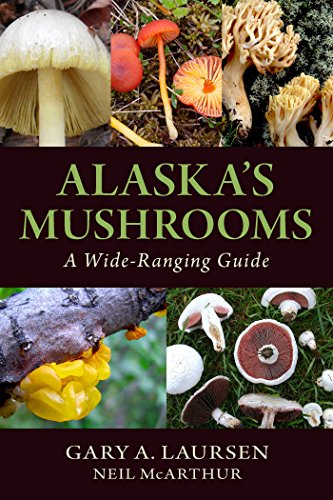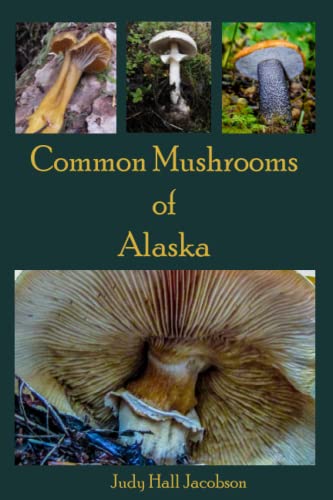Alaska is an interesting place for mushrooms. Not surprisingly, it has a number of species that are either absent or less common outside of the state. What may be a surprise, though, is that while few Alaskan mushrooms are actually poisonous, there are a great many that you really ought not to pick—because their edibility is known, because they are rare, because they don’t taste good, or because they closely resemble something dangerous. Our list of edible mushrooms reflects that paradox. But there are plenty that are good eating, too, and in any case, we want to introduce you to a small sampling of the diversity that is Alaskan mushrooms[i].
Some edible mushrooms are relatively easy to identify. Some are easy to mix up with species that can kill you, especially if you neglect certain details, such as spore color. Some that we used to think we knew well have turned out to be something else again. It’s not that mushrooms are mysteriously difficult (red Russulas are, but most aren’t), but it’s easy to overlook important features in the beginning. That’s why it’s best to not forage for the table until you are more experienced at identification. To whet your appetite, though, here are just a few of the edible mushrooms Alaska has to offer.
If you do indeed go Mushroom Hunting make sure you have the proper tools, take a quality knife with you and a basket/bag for your haul!
The point of this article is to show you why putting in the work to become an experienced forager is worth it. This list is not meant to be used as a replacement for a field guide, spore prints, an identification app or an in person guide.
Our Recommended Field Guides
COVER | TITLE | Header | ||
|---|---|---|---|---|
OUR #1 RATED | ||||
Edible Mushrooms in Alaska
Chanterelles


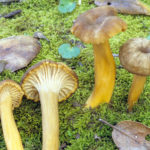

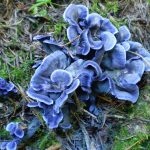

Although Cantharellus is generally regarded as the chanterelle genus, the common name “chanterelle” shows up attached to some members of several other genera as well, since all three share the same distinctive shape—like the bell of a trumpet with ridges or veins rather than gills. Most (though not quite all) are edible.
The Pacific Golden Chanterelle (Cantharellus formosus) is a prized edible, part of a group of yellow chanterelles that are, collectively, among the most popular edible mushrooms in the world. Yellowfoot (Craterellus tubaeformis), which is small and yellow and brown, is also good, but not as choice. It is very common in the southern part of the state. Blue chanterelle (Polyozellus multiplex) is very pretty to look at, though opinion splits as to the taste—which is just as well, as it is so rare it should not be harvested.
Boletes
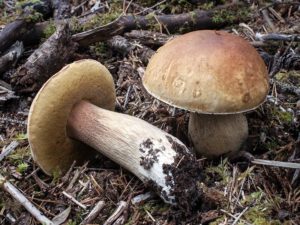

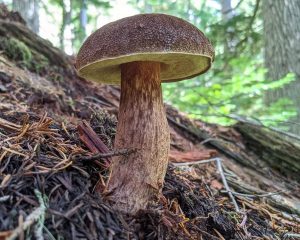

The Boletes all share in common a fleshy, toadstool shape and, in place of gills, a layer of pores. Many are edible, but some are not. The group is in the process of a taxonomic reorganization, with the unfortunate result that some of them have their scientific names change literally ever few years. One group, the King Boletes, are particularly popular as food, and Alaska has at least one species, though it’s difficult to find accurate information on which King Bolete it is, since many writers still regard them as a single species. The Admirable Bolete (Aureoboletus mirabilis) is almost as good and tastes pleasantly of lemon. Most of Alaska’s other Bolete species are either not as good or not edible at all.
Catathelasma ventricosum and Catathelasma imperiale
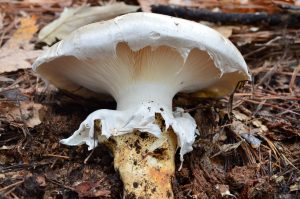

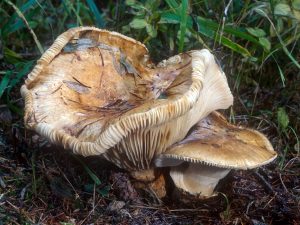

These two species are easy to confuse with each other, but both are large and safe to eat. Opinion diverges wildly on whether they are worth eating. Some people love them. Others don’t see the point.
Shaggy Mane (Coprinus comatus)
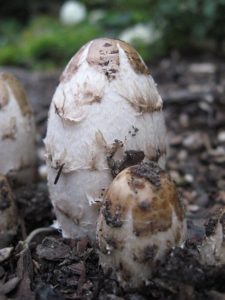

The shaggy mane is one of several mushroom species with the charming habit of turning to black goo at maturity. Fortunately, before they turn to goorbn 2, they are quite tasty—and the goo, which does work as ink, can be used to add both color and flavor to various foods. The only real problem is if you want a mushroom, goo probably isn’t going to satisfy you, and once picked they will start gooifying very quickly. They can be dried, but the process is tricky, since, if done wrong, they will simply goo in the dehydrator. Some Inkcaps are incompatible with alcohol, but this one is normally fine to eat while drinking. The point of the goo, by the way, is spore dispersal. The spores are carried away with the goo.
Chicken-of-the-Woods (Laetiporus conifericola)


“Everybody knows” that Chicken-of-the-Woods is a delicious and easy-to-recognize mushroom perfect for beginner foragers. Yeah, except actually “everybody” is wrong, because Chicken-of-the-Woods is really a group of extremely similar species that are easy to mix up with each other—and some may be mildly toxic. Fortunately this species, which likes conifers, hence the name, is safe to eat, but it’s often tough—only the outer edges are tender enough to eat. Fortunately, it is large and often fruits in clusters, so getting enough for a meal shouldn’t be a problem. It does taste like chicken.
Hedgehog (Hydnum sp.)
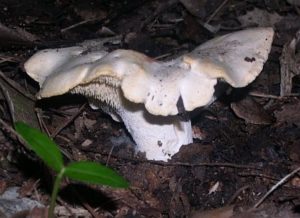

Hedgehog mushrooms have the classic toadstool shape, but instead of gills or pores, they have short, soft spines. They taste rather like the best Chanterelles, though less fruity and more savory. That there are multiple Hedgehog species is a relatively recent discovery. We have not been able to track down which of these species are native to Alaska, but at least one of them is.
Hawk’s Wing (Sarcodon imbricatus)
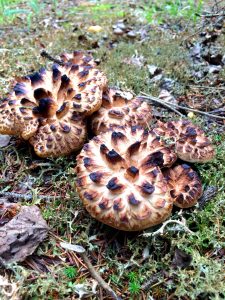

Hawk’s wing mushroom looks almost exactly like Hedgehog mushroom does, except for its much darker color. Its flavor is variable, sometimes good and sometimes unpleasantly bitter. It, too, could be more than one species.
Lackluster Laccaria (Laccaria laccata)
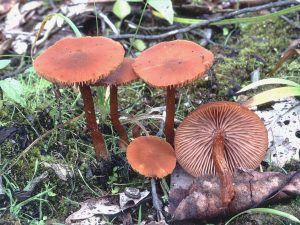

The Lackluster Laccaria is very common in southern Alaska, and you can eat it, but probably shouldn’t. First, its name appears to be apt. Second, this mushroom is variable in its appearance, and at least some of its variations bear a startling, if largely superficial, resemblance to the Deadly Galerina. Seems not worth the risk.
The Gypsy (Cortinarius caperatus)


This mushroom is both common in southern Alaska and popular as table-fare, however it, too, looks a great deal like the Deadly Galerina and is closely related to several other dangerously poisonous mushrooms besides. That doesn’t mean you should not eat it, but you definitely should not harvest it for the table unless you very much know what you are doing. By the way, the word “Gypsy” is an ethnic slur, and while its connection to this mushroom is well-established, perhaps a new name will be in order one of these days.
Shrimp Russula (Russula xerampelina)


Russulas, in general, vary from unpalatable to poisonous, but there are exceptions. The Shrimp Russula, which does indeed smell fishy, is the most popular of these—though the best of a mostly-unpalatable group doesn’t sound all that promising. Its cap comes in such a wide variety of colors that it could well be more than one species.
Alaskan Gold (Phaeolepiota aurea)
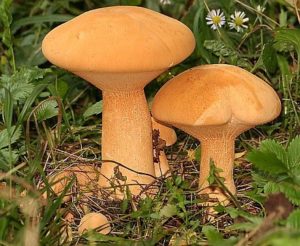

With Alaskan gold, identification is seldom a problem, as not much else combines a bright yellow color with a powdery surface. The problem here is that the mushroom is only safe to eat for most people—a significant minority of eaters end up with gastrointestinal problems. Perhaps gold is best in small quantities, even in Alaska.
Our Recommended Field Guides
COVER | TITLE | Header | ||
|---|---|---|---|---|
OUR #1 RATED | ||||
Poisonous Mushrooms in Alaska
Most mushrooms aren’t poisonous, and most that are cause only mild or moderate illness—many can be eaten without difficulty by some people under some circumstances, making it a judgment call as to whether to consider them poisonous at all. But it’s important to know which mushrooms to watch out for. Of course nobody wants to be even mildly sick, and there are few that really are very dangerous.
The following list is by no means exhaustive. Don’t assume a mushroom is safe just because it isn’t listed here.
Deadly Galerina (Galerina marginata)


What other mushroom combines a deadly dose of poison with an appearance that mimics several culinary mushrooms and most psychedelics? It can even grow with some of its look-alikes in mixed clumps. “Best” of all, it grows pretty much everywhere. It is one of America’s most wide-spread mushrooms.
If you do eat a Deadly Galerina, don’t despair—just get yourself and a sample of the mushroom in question to the hospital as fast as possible. The fact that symptoms can take a day or more to appear will not be in your favor, nor will the fact that symptoms will likely go away after a few days just before major organ failure becomes a serious risk, but some victims are saved by proper medical care. Of course, it’s better not to eat the thing in the first place, which is why only experienced foragers should ever pick LBMs (“little brown mushrooms”) for the table, and then only with care.
False Morel (Gyromitra esculenta)
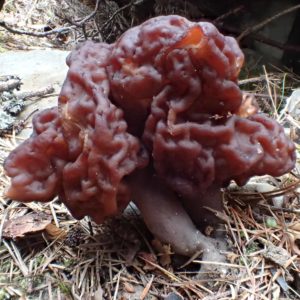

While not usually lethal, this mushroom has caused human fatalities—which is odd given that it’s also a popular edible. The problem seems to be that the toxin is variable in concentration and also cumulative. Much of the toxin can be removed by proper cooking in a well-ventilated area (the fumes are toxic), and if you get lucky and have low-toxin batches to begin with, you could be fine. Fail to cook properly with a high-toxin batch, and you could be not-fine. And if you eat these often over time, while you are seeming to enjoy your mushrooms without any problem at all, the toxin could be accumulating in your body until some inner tipping point is reached and you are very much not fine.
This is not the only False Morel, by the way, and some of the others have much less toxin—they may be legitimately safe to eat, provided proper precautions are taken, a fact that could add to the confusion regarding this one.
Early Morel (Verpa bohemica)
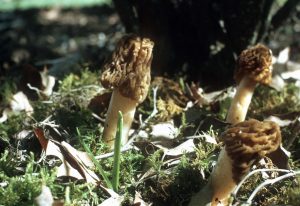

The Early Morel—which isn’t a morel but could be mistaken for one—is another popular edible that sometimes makes people quite ill. Of course, so do true morels. It’s always a judgment call whether to consider certain mushrooms “edible but with caution” or “poisonous but not for everybody.” An important point in favor of putting the early morel in the latter group is that, as with the false morel, you could eat these without ill effect regularly for years and then suddenly get sick with no warning.
There are other early morel species, too, but few look quite so morelish as this one does.
Fly Agaric (Amanita muscaria)
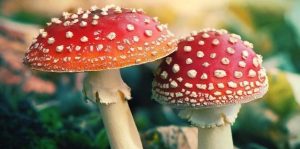

Ah, yes, another judgment call, the famously psychoactive fly agaric, usually referred to by psychonauts by its graceful scientific name. We’ve got it listed with the poisonous species—are we just trying to trick people into avoiding a fun trip? No, we aren’t. In fact, we sometimes list this one among the magics, though its active ingredient is not psilocybin. The reason we’ve listed it among the poisonous species this time is it is poisonous, usually not fatally so, but the effects are highly unpleasant—victims end up seriously ill while tripping, and that is not a good combination, especially for people who didn’t expect to be tripping at all. Safe use requires proper processing, and not everybody who tries to do it does it right.
Amanita muscaria is a lovely mushroom, though, and possibly the most famous mushroom in the world because of its long-time use in art (not surprisingly, it is associated with fairies and magic in some cultures). This is the original red-capped mushroom with white spots (though color can vary from yellow through to brown), and well worth admiring for its beauty alone.
Red Russulas (Russula sp.)
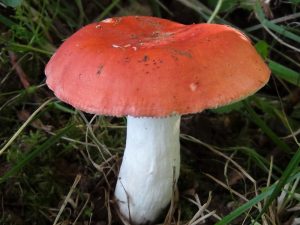

One of the first mushrooms many people learn is the Emetic Russula, also known as The Sickener. It is red and white with a very distinctive look—and, of course, there is the memorable name. But you don’t really think it’s that easy, do you? In fact, there are many species of red (or reddish or pink or brownish-red) Russula, and the taxonomy is still a complete mess, with actual, bonafide experts doing things like comparing the cap color to various paint chips under special lamps to try to figure out which is which. Do yourself a favor and don’t worry about it. Most are unpleasantly spicy and likely to cause vomiting anyway.
Red-Hot Milk-Cap (Lactarius rufus)
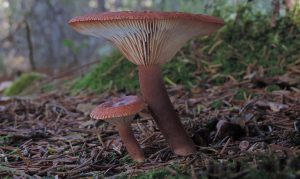

The red-hot milky is not so much red as red-brown, but it is very hot. The heat comes up slowly, like that of a chili pepper. Of course some people (including some of us) like spicy food, but this one might also make you vomit, which is a good deal less fun.
Our Recommended Field Guides
COVER | TITLE | Header | ||
|---|---|---|---|---|
OUR #1 RATED | ||||
Magic Mushrooms in Alaska
“Magic” mushrooms, that is, those that contain the psychoactive substance, psilocybin (or other psychoactive substances) are risky to use. By far, the most serious risk is legal, because use or possession of psilocybin is against both state and Federal law in Alaska[ii]. Penalties can be severe.
Psilocybin itself is not risk-free, as its side effects can be unpleasant and, rarely, dangerous, plus the process of altering consciousness demands a great deal of respect. But as means of altering consciousness go, psilocybin is one of the safer ones.
Perhaps the scariest possibility, and one not commonly talked about, is that most magic mushroom species bear a close resemblance to the Deadly Galerina. People have died making this mistake. Alaska does have several psychoactive species growing wild[iii], but please don’t harvest them to munch on unless you are experienced at correctly identifying mushrooms. We don’t like losing readers.
Psilocybe sp.
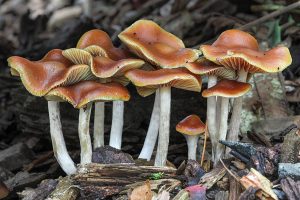

This is possibly the most famous genus of Psilocybin mushrooms, with many popular species, some widely cultivated. However, Psilocybes tend to prefer a warm climate, which Alaska has not got. The Wavy Cap (Psilocybe cyanescens) is the only one that grows wild in the state, and it is quite rare.
Panaeolus sp.
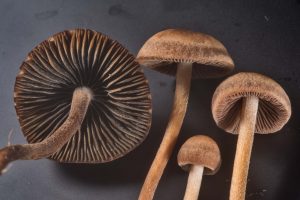

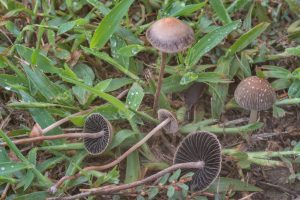

Members of this genus go by the charming common name “Mottlegill,” because their spores mature and darken irregularly, in patches. Psychonauts tend to just call them “pans,” though. Some mottlegills are extremely potent, while others are not psychoactive at all. Both of Alaska’s species occupy spots in the middle of the spectrum. The Banded Mottlegill (Panaeolus cinctulus) is very widespread, appearing across much of North America. It gets its name from the pale band around the rim of the cap. It is moderately potent. In contrast, the Turf Mottlegill (Panaeolus firmicola), so-called because it does often come up in grassy areas, is only very weakly psychoactive and perhaps better left alone.
Gymnopilus sp.
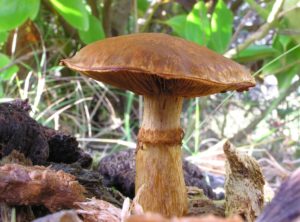

There isn’t much information available on the psychoactivity of the Rustgills, as they are called, except that they are psychoactive, and at least one has earned the nickname, “Laughing Gym.” The taxonomy of the group is a bit muddled, so it’s hard to say which ones Alaska has.
References:
[i] (2013). Mushrooms of the National Forests in Alaska. United States Department of Agriculture
[ii] Dubley, P. (2022). Psychedelics in Alaska: Up-to-Date Laws for 2022.
[iii] (n.d.). Which Psilocybin Mushrooms Grow Wild in My Area? Shroomery
Our Recommended Field Guides
COVER | TITLE | Header | ||
|---|---|---|---|---|
OUR #1 RATED | ||||


